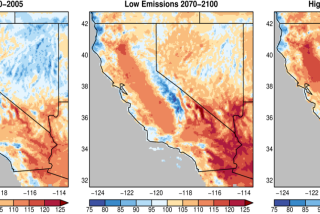Arctic drilling: Groups challenge Shell oil spill response plans
SEATTLE -- In an effort to hold oil companies to a higher standard in the Arctic Ocean, a coalition of conservation groups announced Monday that they are suing to challenge the federal government’s approval of oil spill cleanup plans for Shell Alaska’s upcoming operations in the Beaufort and Chukchi seas.
The lawsuit, which is being filed in U.S. District Court in Anchorage, seeks to invoke the Oil Pollution Act of 1990, a tough law passed in the wake of the 1989 Exxon Valdez oil spill. That law sets a high bar for offshore oil and gas operations — a bar that Shell officials say they are already meeting for exploratory drilling scheduled to get underway in August.
“This lawsuit is not just about this summer. It’s about the future of the Arctic Ocean,” said Michael LeVine, Pacific senior counsel for Oceana, one of 10 plaintiffs. Others include the Alaska Wilderness League, the Sierra Club, Earthjustice and the Center for Biological Diversity.
The suit names the federal Bureau of Safety and Environmental Enforcement, which earlier this year approved separate Oil Spill Response Plans, or OSRPs, for the Beaufort and Chukchi seas. The plans call for a flotilla of on-site response vessels near any offshore drilling rigs and a complement of near-shore response equipment pre-positioned at points along Alaska’s Arctic coast.
“The agency has not done its job to ensure that Shell can remove any spilled oil to the maximum extent practicable, which is the legal standard. They’ve just taken Shell’s word for it that this is the best they can do, rather than taking a hard look at what can be done to actually respond to a spill,” LeVine said in an interview with the Los Angeles Times.
The lawsuit joins a set of preemptive legal actions Shell filed in federal court in Alaska seeking a definitive court ruling on an array of potential challenges to its upcoming drilling operations, including the oil spill response plans.
U.S. District Judge Ralph R. Beistline on June 26 refused to grant the conservation defendants’ motion to dismiss that case, concluding that Shell has a legitimate claim that the company is entitled to have heard in court, even though conservation groups had not yet filed any lawsuits challenging the drilling approvals. The judge also recognized the oil company’s interest in having those potential challenges adjudicated early in order to defend its right to proceed with a drilling operation in which it already has invested $4 billion.
“By threatening to attack such leases through challenging the OSRPs, the organizations would be assailing Shell’s protectable property interests conveyed by such leases,” the judge ruled.
The lawsuit, scheduled to be filed Tuesday, represents the challenge Shell saw coming, but it is not clear how the courts will handle the now-competing lawsuits. This is largely uncharted legal territory, conservation attorneys said.
It is possible that the court could decide to consolidate them, or dismiss one of them. LeVine said the plaintiffs in the new case aren’t seeking an immediate halt to Shell’s operations for the upcoming 2012 season but to enforce a higher standard of review for what is likely to be a march of new offshore operations in the Arctic if Shell’s exploratory drilling is a success.
“When this case reaches a decision, as far as we’re aware, it’ll be the first of its kind interpreting the Bureau of Safety and Environmental Enforcement’s obligation to protect the oceans in the case of a major spill,” he said.
Specifically, the plaintiffs allege that the Oil Pollution Act requires the federal government to require a much more exhaustive response capability to a potential spill and to take into account that an accident late in the drilling season could mean trying to clean up oil as ice begins to form across the Arctic seas. They contend the capping stack intended to shut off a well blowout and other response equipment should have been tested in the Arctic, rather than off the coast of Washington state.
The last broken-ice cleanup drills in the Alaskan Arctic using skimmers and booms were conducted in 2000 in advance of another company’s drilling operations and were largely considered a failure.
The Bureau of Safety and Environmental Enforcement “rubber-stamped plans that rely on unbelievable assumptions, include equipment that has never been tested in Arctic conditions, and ignore the very real possibility that a spill could continue through the winter,” the plaintiffs said in a statement. “The agency has not met minimum legal standards to be sure that Shell’s plans could be effective and that Shell has sufficient boats, resources, and spill responders to remove a ‘worst-case’ oil spill in the Arctic Ocean to the ‘maximum extent practicable.’”
Shell officials said they had not seen the lawsuit but were confident the company had implemented a robust response program that would be able to contain the majority of any spilled oil in the vicinity of the drilling rigs in the unlikely event of any rupture.
“We remain confident that the approval of our oil spill response plans will withstand any legal review,” company spokesman Curtis Smith said. “We said it before, but these approvals, we think, are a testament to the huge amount of time, technology and resources that Shell has dedicated to an Arctic oil spill response fleet that is second to none in the world.”
He said the company anticipated all along that conservation organizations would challenge Shell’s drilling operations — which was why the company filed the earlier legal actions.
“We don’t have an issue with them filing against the plans. We never had an issue with that,” he said. “We just wanted to bring on that conversation sooner, rather than later.”
ALSO:
Texas rejects two pillars of new federal healthcare law
Maine’s GOP governor likens IRS to Nazi Germany‘s Gestapo
Quake-damaged Washington Monument may be closed until 2014
More to Read
Sign up for Essential California
The most important California stories and recommendations in your inbox every morning.
You may occasionally receive promotional content from the Los Angeles Times.










